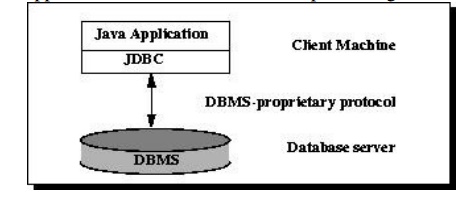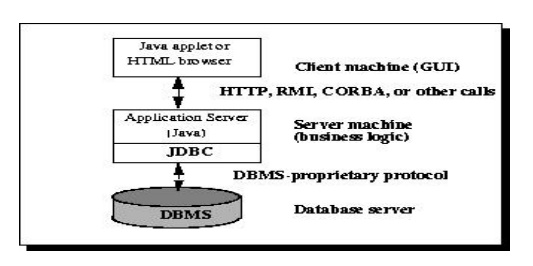Chapter: Web or internet Programming : Server Side Programming
Multitier Application
Multitier Application
The JDBC
API supports both two-tier and three-tier processing models for database
access.

In the
two-tier model, a Java application talks directly to the data source. This
requires a JDBC driver that can communicate with the particular data source
being accessed. A user's commands are delivered to the database or other data
source, and the results of those statements are sent back to the user. The data
source may be located on another machine to which the user is connected via a
network. This is referred to as a client/server configuration, with the user's
machine as the client, and the machine housing the data source as the server.
The network can be an intranet, which, for example, connects employees within a
corporation, or it can be the Internet.

In the
three-tier model, commands are sent to a "middle tier" of services,
which then sends the commands to the data source. The data source processes the
commands and sends the results back to the middle tier, which then sends them
to the user. MIS directors find the three-tier model very attractive because
the middle tier makes it possible to maintain control over access and the kinds
of updates that can be made to corporate data. Another advantage is that it
simplifies the deployment of applications. Finally, in many cases, the
three-tier architecture can provide performance advantages.
Until
recently, the middle tier has often been written in languages such as C or C++,
which offer fast performance. However, with the introduction of optimizing
compilers that translate Java bytecode into efficient machine-specific code and
technologies such as Enterprise JavaBeans™, the
Java
platform is fast becoming the standard platform for middle-tier development.
This is a big plus, making it possible to take advantage of Java's robustness,
multithreading, and security features.
With
enterprises increasingly using the Java programming language for writing server
code, the JDBC API is being used more and more in the middle tier of a
three-tier architecture. Some of the features that make JDBC a server
technology are its support for connection pooling, distributed transactions,
and disconnected rowsets. The JDBC API is also what allows access to a data
source from a Java middle tier.
Related Topics